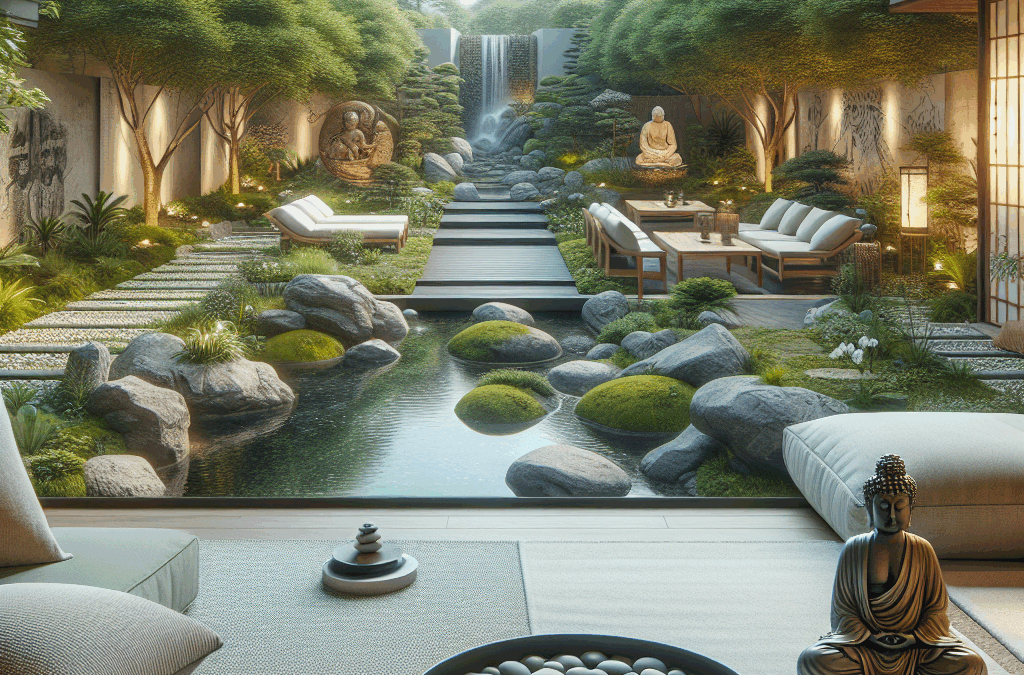Creating Tranquil Zones
Understanding the Essence of Tranquility
When I first started thinking about meditation spaces, I realized that tranquility isn’t just a lack of noise; it’s a nurturing environment that allows us to connect with ourselves. After digging into various practices, I’ve come to appreciate how nature forms the backdrop for inner stillness. Nature has a calming effect, and finding or creating a tranquil spot is the first step towards cultivating a meditative space.
Could it be your backyard under a comforting tree, or maybe a cozy nook in your living room? I often find that natural light, soft textures, and earthy colors can amplify feelings of peace. When the space resonates with calmness, it sets the stage for my mental and emotional rejuvenation.
Beyond physical changes, there’s a mindset component too. Embracing simplicity—both in my surroundings and my thoughts—has led to profound changes in my life. It’s about welcoming the present moment and releasing distractions. This is where my journey towards silence truly began.
Designing Your Personal Retreat
Your personal retreat doesn’t need to be extravagant or far away; it can be simple and homey. I started by selecting items that spoke to me personally—things that spark joy and invite calm. This might mean using cushions or blankets displaying calming colors and softness. I’ve found that comfortable seating is essential; my meditation sessions can be long, and a cozy chair or a plush mat makes all the difference!
Incorporating elements like plants or water features can further enhance this retreat. I remember adding a small fountain in my garden nook—it brought that gentle bubbling sound that was utterly soothing. Plus, the fragrance of plants adds an aromatic dimension to the experience. It’s all about layers of sensory invitation that make me want to spend time in these special corners of my home.
Furniture positioning matters, too! I like to think of how I can create a flow that encourages me to stay, perhaps by facing a lovely view or a fire pit. Think about what natural features you have and how you can channel their energy to help cultivate this calming space. Everything, from the arrangement to color selection, plays a role in the vibe of your meditative space!
Incorporating Mindful Elements
It’s amazing how small details can enhance a space’s energy. For me, adding items like scented candles, crystals, or sound bowls allows me to engage multiple senses. Each piece I choose has a story or reason behind it; they serve as reminders of calmness and focus every time I glance their way. It’s like they radiate an invitation to relax.
The scent of essential oils diffusing in the air is another game-changer for me. I find that lavender or sandalwood really helps in grounding my mind and centering my thoughts. Having a small diffuser nearby creates a cozy atmosphere while inviting serenity to wash over me.
In the end, it’s all about intention. Each element you place in your meditative space should serve a purpose, whether it’s a reminder to breathe deeply or to focus your energy. When I sit down to meditate, I can feel the collective energy of these pieces guiding me towards tranquility.
Setting Boundaries
Creating a Distraction-Free Zone
I can’t emphasize enough how critical it is to create a space that’s truly distraction-free. Have you ever tried to meditate with your phone buzzing or the TV blaring? Yeah, it doesn’t work for me either! My personal rule is to turn off notifications and set my phone to ‘Do Not Disturb’ mode. This small step alone has made a huge difference in my ability to focus.
Sometimes I also place a ‘quiet time’ sign or designate specific hours when nobody is allowed to interrupt my space. Setting these boundaries—not only with ourselves, but also with family or friends—ensures that my meditative practice becomes sacred and uninterrupted.
In extreme instances, I’ve even stepped outside to a beautiful part of my yard or visited a nearby park where nature does the heavy lifting. Limiting distractions has made each session more fulfilling. It’s about giving myself permission to simply be without interruptions!
Getting Family On Board
Involving family in your meditative efforts can be beneficial, but it also might need some convincing! I gradually introduced my family to the idea of mindful moments together until they saw its value. By explaining how meditation helps me—how peaceful it feels—they slowly began to come around.
Having a serene space available for family groups was essential too. We now have a family meditation time every Saturday morning. Setting a specific time really kicked things off! We gather in our backyard, away from our phones, and just embrace the stillness together. Over time, everyone has found their own rhythm and way to connect.
These shared moments foster openness within our family too. Discussing our experiences after we meditate has opened up a new space for conversation, patience, and understanding. It’s been one of those unexpected blessings that continues to unite us!
Regularly Refreshing the Space
Seasonal Changes
I love to reflect the changing seasons in my meditative space. This practice is often as simple as swapping out plants or changing the decor. Each season offers a unique aesthetic and emotional landscape—embracing them helps keep things fresh and engaging! In spring, fresh flowers add beauty; in winter, soft, warm lighting can create a cozy atmosphere.
The seasonal decorations I use are often natural materials—like pinecones or autumn leaves—align seamlessly with the cycle of nature. This isn’t just a visual change; it enriches my spiritual connection to nature. Connecting with the earth’s rhythms adds depth to my experience, making it feel alive and dynamic.
It’s important to listen to your space, too. Sometimes a simple rearrangement of furniture or adding new elements can revitalize the energy. Checking in regularly and being adaptable is key to keeping that space inviting. Change doesn’t have to be drastic; it can simply mean letting things evolve naturally!
Personal Reflection and Growth
Over time, the journey of meditation invites us to grow and discover new aspects of ourselves. After a few months in my meditative space, I like to conduct an independent reflection. I ask myself questions—are there aspects of the space that could serve me better? Am I still connecting with it the same way? This self-check can be illuminating and helps me make adjustments.
Sometimes, I’ve even incorporated a journal to jot down changes I’m experiencing or lingering thoughts during my practice. It’s surprising to look back and see how my mindset has shifted and where I’ve found progress! The space becomes a mirror for personal growth, evolving alongside me.
In the spirit of ongoing evolution, I also encourage my friends to explore their journey within their spaces. Sharing our experiences often fuels motivation and insights. It helps remind us that these meditative practices are alive, transforming us through time as we cultivate silence.
Embracing the Silence
Finding Your Inner Stillness
Finally, embracing the silence is about allowing ourselves to just be still. Initially, I found it difficult to quiet my thoughts, but over time, I’ve realized that it’s perfectly okay. Instead of forcing stillness, I learned to ease into it, welcoming whatever floats into my mind. Meditation is as much about observing our thoughts as it is about crafting silence.
I particularly enjoy focusing on my breath. It becomes a grounding lifeline that draws me back when my mind wanders. After all, my breaths are always present, reminding me to connect with the here and now. Sometimes I giggle at my mind’s antics, and acknowledging that brings a lightness to my practice. Meditation is a journey, not a destination!
Ultimately, embracing silence in your space means offering yourself grace. Accepting that some days will feel easier than others brings a comforting equality to the process. By following this, I’ve been able to cultivate an ongoing relationship with my meditative space that grows and deepens over time.
FAQs
1. How do I start creating a meditative space at home?
Begin by choosing a quiet spot that resonates with you. Incorporate comfortable seating, calming decor, and elements that bring you joy, such as plants or soft textiles. Make it a distraction-free zone by setting boundaries with others and minimizing noise.
2. Can I mediate in a small space?
Absolutely! Even a corner of your bedroom or a cozy chair can serve as a great meditative space. The key is to create an atmosphere that feels inviting and calming, regardless of the size.
3. How often should I refresh my meditative space?
It’s great to refresh your space seasonally, or whenever you feel like it needs a change. Staying attentive to your surroundings allows you to adapt and evolve your space to your current needs.
4. What if I’m struggling to meditate?
That’s totally normal! Start small and be gentle with yourself. Focus on your breath and remember that it’s okay if your mind wanders. The more you practice, the easier it may become!
5. Can I invite family members to join my meditative practices?
Yes! Introducing family can enrich your experience. Schedule shared meditation times and create a collective space for mindfulness. It’s a beautiful way to bond and explore meditation together!





